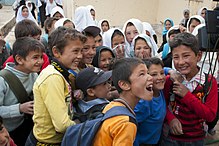Hazaras

Ethnic Hazara school children in Bamyan, 2012
|
|
| Total population | |
|---|---|
| c. 5–8 million | |
| Regions with significant populations | |
|
|
~6,000,000 (2014), 20% |
|
|
2,000,000. some ~ 500,000 Afghan citizens of Hazara descent in Iran (2011) |
|
|
900,000. Some ~ 40,000 Afghan citizens of Hazara descent in Pakistan (2005) |
|
|
10,000 (2013) |
|
|
4,300 |
|
|
3,800 |
| Languages | |
| Persian (predominantly Dari and Hazaragi dialects) | |
| Religion | |
| Shia Islam (Twelver and Ismaili), with a Sunni minority (see Aimaq Hazara) | |
4,300
3,800
The Hazaras (Persian: هزاره) are a Persian-speaking people who mainly live in central Afghanistan, Hazara Town in Balochistan, Pakistan, and Karachi. They are overwhelmingly Twelver Shia Muslims and make up the third largest ethnic group in Afghanistan.
The dialect of Persian which they speak is called Hazaragi, which is more precisely a part of the Dari dialect continuum (one of the two main languages of Afghanistan), and is mutually intelligible with Dari.
Babur, founder of the Mughal Empire in the early 16th century, records the name Hazara in his autobiography. He referred to the populace of a region called Hazaristan, located west of the Kabulistan region, north of Ghazna and south-west of Ghor.
The conventional theory is that the word Hazara derives from the Persian word for Thousand (Persian: هزار – hazār). It may be the translation of the Mongol word ming (or minggan), a military unit of 1,000 soldiers at the time of Genghis Khan. With time, the term Hazar could have been substituted for the Mongol word and now stands for the group of people.
The origins of the Hazara have not been fully reconstructed. Significant inner Asian descent – in historical context Turkic and Mongol – is impossible to rule out because the Hazara's physical attributes, facial bone structures and parts of their culture and language resemble those of Mongolians and Central Asian Turks. Thus, it is widely and popularly believed that Hazara have Mongolian ancestry. Genetic analysis of the Hazara indicate partial Mongolian ancestry. Invading Mongols and Turco-Mongols mixed with the local Iranian population, forming a distinct group. For example, Nikudari Mongols settled in what is now Afghanistan and mixed with native populations who spoke Persian. A second wave of mostly Chagatai Mongols came from Central Asia and were followed by other Mongolic groups, associated with the Ilkhanate and the Timurids, all of whom settled in Hazarajat and mixed with the local, mostly Persian-speaking population, forming a distinct group.
...
Wikipedia
